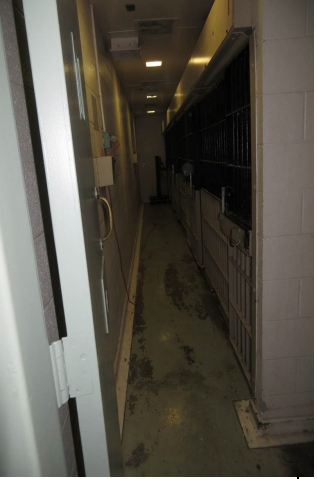‘Extreme Isolation Cells’ Banned from Santa Barbara County Jail
Settlement Reached in Class-Action Lawsuit Against County, Sheriff’s Office over Conditions at Main Jail

In a breakthrough settlement last Friday, Santa Barbara County and its Sheriff’s Office reached an agreement in a class-action lawsuit alleging unsafe conditions in the Main Jail — including a ban on “extreme isolation cells” and a drastic increase of out-of-cell time for inmates.
The lawsuit, Murray v. County of Santa Barbara, was filed in December 2017 and names inmates Clay Martin Burt Murray, David Franco, Shareen Winkle, Eric Brown, and Maria Tracy as the plaintiffs. It lists Santa Barbara County and the Sheriff’s Office as defendants.
Get the top stories in your inbox by signing up for our daily newsletter, Indy Today.
The suit alleges that the living conditions in the Main Jail are overcrowded and unsanitary. More specifically, it charges that the Sheriff’s Office does not provide adequate mental-health and health services to inmates, that it practices “harmful and excessive use of solitary confinement,” and that it discriminates against disabled inmates.
“We have communicated with hundreds of people held in the Santa Barbara County Jail, and have heard again and again that the conditions there are simply intolerable,” said Aaron Fischer, litigation counsel at Disability Rights California. “The design and conditions of this half-century old jail have no place in modern society. … With this settlement, the community should expect significant improvements in conditions at the [jail.]”
The final settlement comes after months of negotiations and years of attempts to relieve the overcrowding issue. In light of the ongoing struggle to better the jail, many of the points for improvement in the lawsuit had already been in the works or completed before reaching Friday’s settlement. The onset of the COVID-19 pandemic has also spurred changes ahead of time.
The Sheriff’s Office had begun to chip away at jail overpopulation, which has remained a festering issue for decades, by initiating an early release program for sentenced inmates. The population was even further reduced by the Zero Bail initiative, a now-expired state Judicial Council mandate that set bail to zero for non-violent crimes during the pandemic, putting the population at a historic low.
The original suit cited the jail’s average population at 120 percent of its capacity, frequently exceeding 1,100 people. Because of early release and zero bail, the population is currently hovering around capacity at about 570. The settlement requires that the number of prisoners placed in a housing unit must be limited to no more than the rated capacity, and everyone must be assigned an actual bed.
According to the lawsuit, many prisoners — including those with serious health conditions and disabilities — slept on the floor due to overcrowding. Though the settlement doesn’t agree on a specific maximum number of inmates, it requires the county to keep the inmate population within the capacity, regardless of if it only operates parts of the Main Jail or it chooses to also operate the soon-to-be-completed Northern Branch Jail.
“Maintaining and further reducing the current jail population — and shrinking the footprint of the county’s jail system — is, without question, the best pathway to cost-effective and successful implementation of the remedial plan,” said Corene Kendrick, staff attorney at the Prison Law Office. “It’s the right thing to do for the safety and well-being of our class members, and it’s the right thing to do for the Santa Barbara County community at large.”
The settlement also stipulated terms around inmates with disabilities. The original complaint asserted that inmates with disabilities were placed in South Dorm 25, though many of those inmates slept on the floor because of disabilities preventing them from sleeping on a top bunk. The toilet and shower areas also do not meet architectural standards for wheelchair use and lack properly placed grab bars, showerheads, and so on.
The main plaintiff in the case, Clay Martin Burt Murray, is a 69-year-old U.S. Army veteran who uses a wheelchair due to degenerative joint disease and has post-traumatic stress disorder. Murray is serving life without the possibility of parole for first-degree murder.
Murray charged that he never received any treatment in custody to help with his PTSD symptoms despite multiple requests and because of his wheelchair he was regularly forced to sleep on the floor. The complaint stated: “Activities as basic as taking a shower or using the toilet put Mr. Murray at risk of injury every day.” Other plaintiffs in the case, particularly those with mental illnesses, similarly charged that the jail was not providing them with treatment and even withholding prescribed medication.
The settlement tackles these issues in multiple ways. Aside from requiring the population to stay below maximum capacity and that every inmate be assigned an actual bed, it bolsters mental-health services, too.
The settlement brings structured mental-health programming to the jail for the first time. One of the key components to the programming allows inmates with significant mental-health needs to get at least six hours per week of “structured out-of-cell time” for therapeutic group or individual programming, and 12 hours per week of “unstructured out-of-cell time,” which can include time in the dayroom, outdoor or recreation time, and other activities.
Changes to solitary confinement practices are perhaps the most groundbreaking in the settlement. The county agreed to stop all use of its “extreme isolation cells” and all solitary confinement cells that lack dayroom access by January 2021. The complaint describes the cells as “windowless, dimly lit, filthy, and lacking fresh air.” It shows photos of cells in dark hallways where the inmate would have no way of being heard if they needed to call out for help.
It also bumped the mere three hours per week of out-of-cell time to 18 hours plus additional in-cell enrichment time with a tablet for those who need to be in isolation temporarily. These changes are a massive step from conditions described in the 2017 complaint, which also alleged Main Jail inmates were being held in isolation far too long without proper monitoring.
“One cell, called ‘South 20,’ is located by itself down a long and winding hallway behind an additional door,” the 2017 Disability Rights California report about the jail’s conditions says. “An individual can spend weeks or months in this cell without any normal or meaningful interaction with another person.”

Use of these types of cells are banned entirely in the agreement, and those inmates who must be placed in isolation will only be placed in approved cells with light and more space in addition to the added out-of-cell time. There are at least 40 of the “extreme isolation cells” that are banned in the settlement.
To ensure these promises are kept, progress will be monitored by class counsel as well as agreed-upon experts. The experts include Kerry Hughes, MD (mental health, suicide prevention), Homer Venters, MD (medical care), and Michael Brady/Sabot Group (ADA and health/safety conditions).
“Although our custody professionals have performed admirably for years, they have been hampered in their efforts by limited resources and an obsolete and inefficient jail facility that is more than 50 years old,” Sheriff Bill Brown said. “The much-welcomed … expert evaluations and remedial plans that are a part of this agreement will pave the way toward a comprehensive community of care for the entire inmate population.”
To read the full 50-page settlement with additional stipulations, click here.
Every day, the staff of the Santa Barbara Independent works hard to sort out truth from rumor and keep you informed of what’s happening across the entire Santa Barbara community. Now there’s a way to directly enable these efforts. Support the Independent by making a direct contribution or with a subscription to Indy+.






You must be logged in to post a comment.